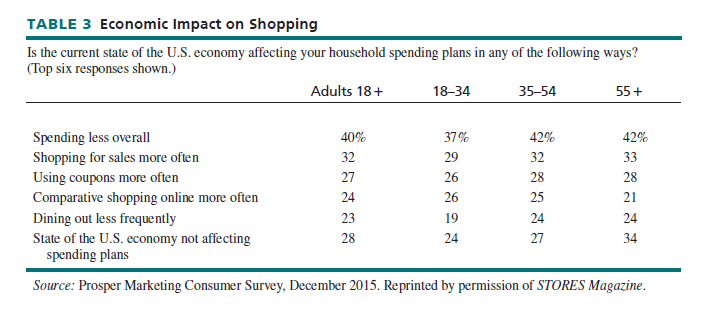It is generally acknowledged that consumers’ propensity to spend varies by age, as do the types of products they purchase. Age-wise, Millennials are on the cusp of what experts deem to be the sweet-spot for spending—setting up homes, starting a family, and so on—but that’s just not typically been the reality.
Burdened by student debt, many in this age group spend money primarily on mobile devices and media content. They are champions of the sharing economy and sustainability, content to rent rather than own everything from special occasion apparel and jewelry to cars. The research aligns: 18- to 34- year-old respondents are more likely than any other group to consider on-demand video streaming untouchable—42 percent, compared with 29 percent of 35- to 54-year-olds. They also are less apt to give up their daily cup of gourmet coffee, their gym membership, and their costume jewelry as compared with other adults.

“Millennials are now the largest generation of potential shoppers and they have certain traits that are shaping their buying habits. They’ve lived through the Great Recession and it has had an effect on them: They tend to be frugal,” says Paula Rosenblum, co-founder and managing partner at RSR Research. “If you ask them if purchasing jeans is expendable, they’ll say ‘Sure,’ because they can buy another pair from H&M for $20. This generation has grown up with fast fashion; and when you are buying from those types of retailers, everything becomes expendable.”
Rosenblum is quick to point out that although Millennials may be frugal, they are interested in quality, as exemplified by their desire to have the latest smartphone and a willingness to invest in items that inspire and speak to their social consciousness. “Part of the reason why department stores and some specialty retailers are in a world of hurt is because Millennials don’t want to go into stores and wander; and they definitely don’t want to wear logos emblazoned on their chest. They favor curated assortments that are in line with who they are.” As a result, some long-established retailers “are going to have to find a way to reinvent themselves if they expect to return to relevancy,” states Rosenblum.
Source: Barry Berman, Joel R Evans, Patrali Chatterjee (2017), Retail Management: A Strategic Approach, Pearson; 13th edition.

Wow! Thank you! I continually needed to write on my site something like that. Can I include a part of your post to my site?